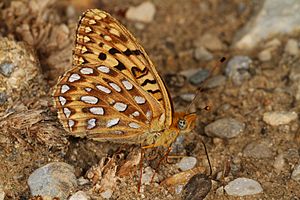Coronis fritillary facts for kids
Quick facts for kids Coronis fritillary |
|
|---|---|
 |
|
| Scientific classification | |
| Synonyms | |
|
The Coronis fritillary (scientific name: Speyeria coronis) is a beautiful butterfly found in North America. It belongs to the Nymphalidae family, which is a large group of butterflies often called "brush-footed butterflies." You can find these butterflies flying across a wide area, from Baja California in the south all the way up to Washington in the north. They also live eastwards into Colorado and western South Dakota. There was even one sighting reported in Alberta, Canada!
This butterfly is known for its striking colors. It is mostly bright orange and yellow. On the top side of its wings, you'll see clear, dark-brown stripes. The edges of its wings are dark, with lighter circles and then dark crescent shapes. If you look at the underside of its wings, especially the yellowish parts, you'll notice many shiny, silvery spots. These spots make the Coronis fritillary quite unique.
About the Coronis Fritillary
The Coronis fritillary is a medium-sized butterfly. Its wingspan, which is the distance from one wingtip to the other when the wings are spread out, can be anywhere from 60 to 86 millimeters (about 2.4 to 3.4 inches). This makes it about the size of a credit card or a little bigger.
What Do They Eat?
Like all butterflies, the Coronis fritillary starts its life as a larva, also known as a caterpillar. These caterpillars have a very specific diet. They love to munch on plants from the Viola species. Violets are small, often purple or white flowers that grow close to the ground. The caterpillars need these plants to grow big and strong before they turn into a chrysalis and then a butterfly.
Similar Butterflies
Sometimes, it can be tricky to tell the Coronis fritillary apart from other butterflies that look similar. Here are a couple of species that might be confused with it:
- The Zerene fritillary (Speyeria zerene)
- Edwards' fritillary (Speyeria edwardsii)
These butterflies share similar colors and patterns, but if you look closely, you can spot the differences in their markings and where they live.

